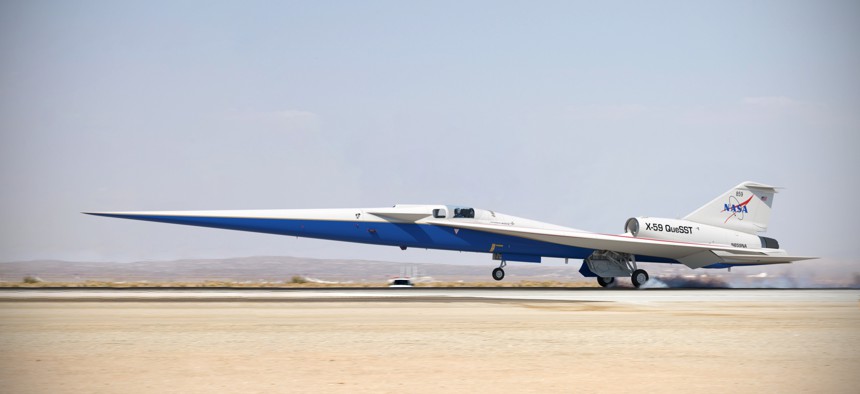NASA, Virgin Galactic Team Up to Advance Supersonic Tech for Point-to-Point Travel

NASA has worked for decades to develop high Mach vehicles and fly faster than the speed of sound, such as the recently tested X-59 QueSS. Illustration by Lockheed Martin
The work will be conducted via a Space Act Agreement.
Virgin Galactic joined forces with NASA to produce ultrafast, next-generation flight vehicles capable of point-to-point air travel across planet Earth.
The spaceflight business and its subsidiary, The Spaceship Company, signed a Space Act Agreement with NASA to collaboratively help generate “technically feasible, high Mach vehicles”—think: supersonic jets—that hold potential for civil applications, according to an announcement released Tuesday. Such agreements empower the space agency to partner up with organizations to specifically support its mission and needs, as it deems appropriate.
Dr. James Kenyon, director of the NASA Aeronautics Advanced Air Vehicles Program said in a statement that the agreement will enable all three “organizations to take advantage of new tools, techniques, and technologies developed over the last 50 years and to explore potential new solutions for the commercial aviation industry.”
The space agency for decades has worked to develop high Mach vehicles and fly faster than the speed of sound. Most recently, NASA tested its X-59 Quiet SuperSonic Technology, or QueSST aircraft, which aims to make almost no sound as it moves. But through the new effort with Virgin Galactic, the agency also aims to explore more economically- and environmentally-viable approaches to pursuing and creating current and new high-speed technologies and applications.
“The collaboration will aim to inform the development of national strategies using economic and technical foundations with a focus on sustainability,” officials wrote in the announcement.
Positioning itself as “the world’s first commercial spaceline,” Virgin Galactic has been aggressively preparing to carry high-paying passengers to and from suborbital space via its spaceship. Offering details around its financial results for the first quarter of the year, also Tuesday, the company announced 400 people put down deposits toward spaceflights in its vehicles down the line. Although commercial space tourism is a top priority, company executives have also hinted that point-to-point hypersonic travel could be transformational for transit and tourism—and supports the company’s own goals.
“Virgin Galactic is seeking to develop a vehicle for the next-generation of safe and efficient high speed air travel, with a focus on customer experience and environmental responsibility,” the release states.
In unveiling the new collaboration, Virgin Galactic Holdings CEO George Whitesides further reiterated those sentiments, and said the forthcoming work with NASA will ultimately advance the overall realm of aviation technology development.
“Virgin Galactic’s unique experience and innovative technology platform will, in partnership with the historic capabilities of NASA and other government agencies, enable the progression of new technical steps that will improve U.S. competitiveness,” he said. “We see this as an area with tremendous growth potential that we will continue to invest in, alongside our commercial spaceflight operations.”
The collaboration follows another Space Act Agreement Virgin Galactic and its subsidiary signed with NASA in late April, which centers around tech-driven efforts against COVID-19.



